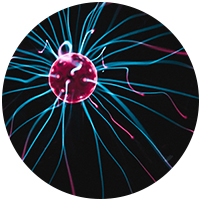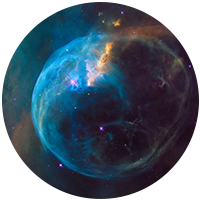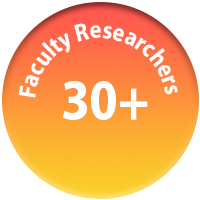Research
The Department of Physics and Astronomy at Western University is a multi-faceted, diverse, and collaborative research environment that addresses key questions and connects world-renowned expertise with relevant communities. Our research efforts within the Faculty of Science aim to drive important discoveries that address key issues facing society and to translate this research into tangible benefits for Canadians. Our research plan is currently under review and an update is expected in Fall 2023.
Our Department differentiates itself not just by its expertise in materials science, medical physics, astrophysics, and planetary science, but in its ability to combine skills in these areas to address big questions like the study of the cosmos from galaxies to atmospheres and manipulation of molecules to develop new materials for medical applications.
We are proud to boast over 30 NSERC-funded researchers, some of whom are Canada Research Chairs, and over 37 active NSERC-funded grants. We developed and cultivated numerous links between academic and industrial partners, and with some of the finest research facilities in Canada. Our researchers are highly collaborative and passionate in their pursuit of research excellence and in educating the next generation of scientists and innovative thinkers.
We are strongly positioned to train students in a unique interdisciplinary context and to link this education to the world beyond university. Our Facilities and dedicated staff support the research goals of our faculty with expertise in their field and world-class fabrication equipment.
Physics

Our physics faculty are a diverse group of researchers cooperating across a broad range of specialties to solve novel problems in collaboration with other Western researchers as well as those from external universities, government and industrial research laboratories. Condensed matter specialists engage in theoretical and experimental research, ranging from computational studies on the quantum properties of solids to world-class materials research in nanotechnology. Our medical physics group innovates with new technology to improve MRI and fMRI systems, researches ultrasound imaging and modelling, and studies methods of improving radiation treatments for cancer. Planetary science investigators encompass a rich and diverse set of disciplines and engage in research including the study of planetary systems and planet formation, discovering and tracking comets, meteors, meteorites and near-earth asteroids, and atmospheric studies to measure temperature, composition and wind speed at high altitudes.
Areas of Expertise
CONDENSED MATTER PHYSICS
Theoretical studies ranging from the quantum properties of solids to dynamics of complex fluids and researching engineered materials from optoelectronic devices to new polymers.
MEDICAL PHYSICS
The application of physics concepts and methods is invaluable in the study, diagnosis, and treatment of human disease.
PLANETARY SCIENCE
This encompasses a rich and diverse set of disciplines ranging from the study of planet formation and planetary systems, to comets, meteors, and asteroids, and Earth's atmosphere.
SCIENTIFIC COMPUTING
Scientific Computing is the study of algorithms and their implementations for computations involving mathematical symbols as well as numbers.
SOFT MATTER AND BIOLOGICAL PHYSICS
With research topics ranging from colloids and polymers to complex fluids and living organisms, soft matter and biological physics are inherently multidisciplinary and related to each other.
THEORETICAL PHYSICS
Research in our department spans both high-energy physics and materials physics.
Astronomy

Western’s astronomers are a highly collaborative group who collectively possess expertise stretching from the largest scales of structure in the universe to the small scales of planetary formation, studying the gas and dust in the interstellar medium in between solar systems and supermassive black holes lurking in the centres of galaxies. Researchers use the newest and most powerful telescopes and develop new instruments to study events from the formation and development of galaxies to witnessing meteors entering our atmosphere. They address questions about the birth, life and death of solar systems, planets, and stars, and reveal new information about their structures, atmospheres and magnetic fields. Our faculty also use innovative computational modelling techniques to study the interstellar medium and circumstellar material surrounding massive stars, applying complex theoretical methods with increasingly powerful computers to address major problems in astrophysics.
Areas of Expertise
Extragalactic
We study the formation and development of galaxies using the latest observations from some of the newest and most powerful instruments available.
Instrumentation
Whether to witness meteors entering our atmosphere or to view the Universe in new ways, we develop state-of-the-art instruments to achieve our goals.
ISM & Circumstellar Material
To study the complex dynamical systems of the ISM or the circumstellar material surrounding massive stars, we use innovative computational modeling techniques.
Solar System
Our Western Meteor Physics Group focuses on studying the interaction of small Solar System bodies with the Earth using a variety of observational techniques.
Star Formation
We have particular expertise at Western in theoretical and computational methods for modeling interstellar gas dynamics and star formation.
Stars
From dusty atmospheres to magnetic fields, we research various properties of the stars in our Galaxy.
Theory
Applying complex theoretical methods with increasingly powerful computers allow us to tackle some of the major problems in astrophysics.
Associated Research Groups
Institute for Earth and Space Exploration
The mission of the Institute is to lead in interdisciplinary research and innovation in Earth and space exploration, and to strengthen and grow the Canadian Earth and space exploration communities through inspiring and training the next generation of scientists, engineers, social scientists and entrepreneurs.
Western Meteor Physics Group
With the only cooperative agreement between NASA and a Canadian university, the WMPG provides real-time measurements of the meteoroid environment to NASA for spaceflight operations and develops meteoroid environment models for spacecraft impact hazard assessment.
Carbon-Based Nanomaterials and Nano-Optoelectronics Group
Research encompasses the preparation of carbon-based and organic nanomaterials and their use for the fabrication of optical and electronic devices such as thin film transistors and solar cells. Applications include memory devices, water filtration, graphene thin films and advanced microscopy techniques.
Interface Science Western
Home of the Tandetron Accelerator Facility, ISW is a part of the Canadian Charged Particle Accelerator Consortium (CCPAC). This facility allows users to undertake a broad range of materials research projects using ion beam analysis and ion implantation.
Canadian Micro-Pulse Lidar Network
A Canadian network of micro-pulse lidars (MPLCAN) capable of profiling the structure of the atmosphere to improve our understanding of particulate impacts on ozone concentration and temperature. The type and amount of particulate present is measured and tracked, including water, ice, pollutants, and even smoke from forest fires across the country.
Centre for Advanced Materials and Biomaterials Research
CAMBR is an organization consisting of approximately 50 research groups with a mission to bring together trainees, researchers, and partners, to connect them with the resources needed to tackle important multidisciplinary materials and biomaterials challenges, and to translate and promote their discoveries.





